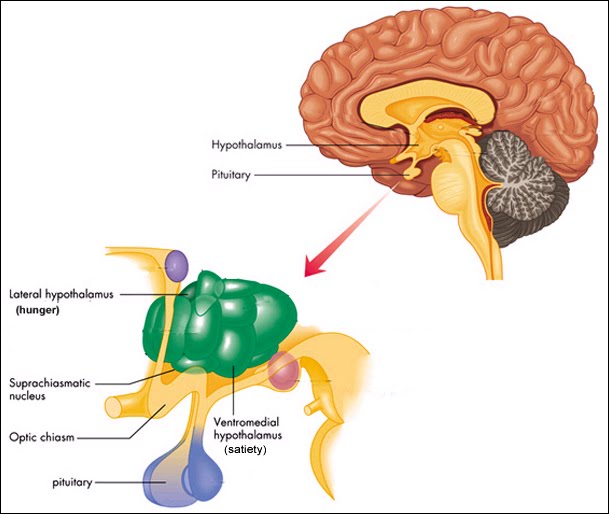
Hypothalamus exerts its influence on almost every function of body. Only the important and better studied functions are discussed below.
Autonomic control
Hypothalamus is primarily considered as ‘higher autonomic center’ to have a control on lower autonomic center for both parasympathetic and sympathetic system present is brainstem and spinal cord. Beside this, hypothalamus is also considered as a center for integration of both autonomic nervous system and endocrine system, thus maintaining body homeostasis. Parasympathetic and sympathetic components of autonomic nervous system are controlled by anterior and posterior parts of hypothalamus respectively. It is also proved experimentally. Electrical stimulation of anterior and preoptic nuclei of hypothalamus leads to increased parasympathetic activities, e.g. lowering of blood pressure, decreased heart rate, hyperperistalsis, contraction of bladder wall, increased salivation and gastric juice and constriction of pupil. Stimulation of posterior and lateral nuclei causes hyperactivity of sympathetic system which is manifested by rise of blood pressure, increased heart rate, diminished intestinal peristalsis and dilatation of pupil.
Neurosecretion
Supraoptic and paraventricular nuclei of hypothalamus are concerned with liberation of vasopressin and oxytocin respectively. Vasopressin basically being selective vasoconstrictor in nature, causes reabsorption of water from distal convoluted tubules and collecting tubules of kidney. Oxytocin increases contractility of uterine musculature and myoepithelial cells in the alveolar wall of mammary gland.
Endocrine control
Tuberoinfundibular nucleus of hypothalamus liberates two hormones called hormone releasing factor and hormone release inhibiting factor. Initially these hormones reach infundibulum of pituitary gland via tuberoinfundibular tract. But finally through the vascular portal system of pituitary gland hormones reach adenohypophysis (anterior pituitary) to exert regulations on different endocrine cells liberating respective hormones. Hormones releasing factor stimulates release of growth hormones, adrenocorticotrophic hormone, thyroid stimulating hormone, follicle stimulating hormone and luteinizing hormone. Hormone release inhibiting factor inhibits release of melanocyte stimulating hormone and lactogenic hormone (prolactin).
Control of body temperature
Normal body temperature is maintained due to balance of function of anterior and posterior part of hypothalamus. Anterior part is concerned for heat loss by cutaneous vasodilation and sweating which result in lowering of body temperature. Posterior part of hypothalamus, if activated, causes vasoconstriction of skin and inhibition of sweating with no heat loss. Skeletal muscle is also responsible for production of heat which results in shivering.
Control of food and water intake
Food intake: Intake of food by an individual is regulated by two centers of hypothalamus called Hunger center and satiety center. Hunger center is present in lateral part of hypothalamus, whereas medial part lodges satiety center. Stimulation of lateral part results in increase in food intake. Lesion of this area will lead to anorexia and subsequent loss of body weight. Stimulation of medial part of hypothalamus containing satiety center inhibits intake of food. Obviously lesion in this area will results in uncontrolled voracious appetite which finally causes excessive obesity.
Water intake: Some area of lateral zone of hypothalamus is known as thirst center. Stimulation of this area makes an individual thirsty with severe urge to drink water. Again, supraoptic nucleus, through its influence on liberation of vasopressin (antidiuretic hormone), maintains optimum osmolarity of blood, thus maintains water balance of body.
Regulation of emotion and behavior
Hypothalamus is considered as principal outlet for action of limbic system for emotion and behavior of an individual through prefrontal cortex. Rage and passivity are two opposite poles of emotion and behavior. These are again dependent upon effect of surrounding environment. Hypothalamus acts as an integrator for various informations received from different areas of nervous system and leads to manifestations of emotion. Lateral nuclei of hypothalamus are considered as the center for rage and ventromedial nucleus is the center for passivity. Tuberal nucleus by synthesis of hormone releasing factors exert influence on secretion of gonadotrophins, thus has an effect indirectly on sexual behavior.
Relation of circadian rhythm
Hypothalamus acts as biological clock through regulation of circadian rhythm. Along with thalamus, limbic system and reticular activating system, hypothalamus regulates cycle of sleeping and waking. Supraoptic nucleus, which receives afferent impulse from retina through optic chiasma, plays an important role in the biological rhythm of sleeping an
Source: Easy and Interesting Approach to Human Neuroanatomy (Clinically Oriented) (2014)